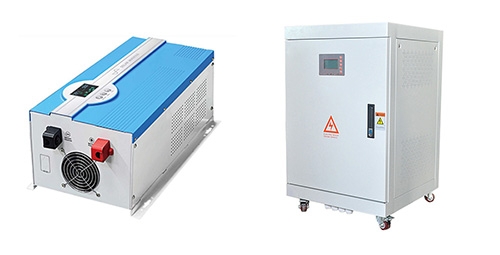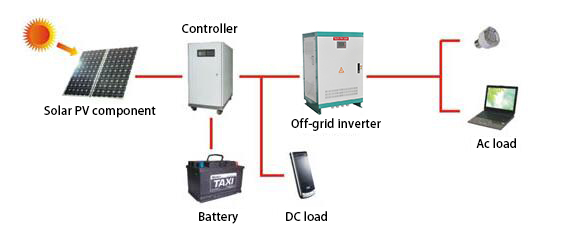In an off-grid solar system with utility power complementation, there are two primary energy sources: photovoltaic (PV) power generation and utility power. The load is the energy consumption point, while the battery both absorbs and releases electricity for the load. Thus, in an off-grid system, the load can be powered by three sources: mains, battery priority, and photovoltaic. Additionally, there are four battery charging modes: photovoltaic priority charging, mains priority charging, photovoltaic independent charging, simultaneous charging of mains and photovoltaics. The application scenarios and requirements of photovoltaic off-grid users vary significantly, so different modes should be selected based on actual needs to maximize photovoltaic use and meet customer requirements.
Inverter.com offers two versions of off-grid solar inverters to meet diverse PV project needs, ensuring efficient and reliable power solutions. One version is a multi-function inverter/charger from 700 watts to 6000 watts, 12V/ 24V/ 48V DC input to 120V/ 220V/ 230V AC output, combining functions of inverter, and battery charger to offer uninterruptible power support with portable size. Another version is a three-phase pure sine wave inverter with high power from 8kW to 200kW, no battery storage design, smart LCD display setting, and powerful protection functions.

PV priority mode
Working principle: In PV priority mode, photovoltaic power is given priority to power the load. If the PV power is insufficient to meet the load demand, the energy storage battery and PV together supply power to the load. When there is no PV power or the battery is insufficient, the inverter automatically switches to mains power if it detects its availability.
Applicable scenarios: It is used in areas without electricity or with insufficient electricity; locations where mains electricity is reasonably priced and frequent power outages occur; as well as users with high power requirements can benefit from this mode, as it ensures continuous power supply even during mains power failures. This mode ensures battery backup in case of mains power failures and reduces dependency on mains power, maximizing the use of solar power. But the potential waste of electricity if the mains power is used when the battery is still sufficiently charged.
Grid priority power consumption mode
Working principle: In this mode, the utility power supplies power to the load whenever it is available, regardless of the presence of photovoltaic power or battery charge. The system only switches to photovoltaic and battery power if the utility power fails.
Applicable scenarios: It is used in locations with stable and inexpensive mains voltage but limited power supply times, and scenarios where photovoltaic energy storage serves as a backup UPS power supply. The advantage of this mode is that it lowers initial investment due to the few photovoltaic modules required, ensuring a stable power supply from the grid when available. Additionally, integrating a pure sine wave UPS inverter can ensure a more reliable and efficient conversion of stored energy, providing clean and stable power output. However, it will cause a higher potential for photovoltaic energy waste, as solar power may not be utilized fully.
Battery priority mode
Working principle: In this mode, photovoltaic power is prioritized to power the load. If PV power is insufficient, the energy storage battery and PV together supply power to the load. When there is no PV power, the battery supplies power to the load alone. If the battery power is also insufficient, the inverter switches to mains power.
Applicable scenarios: Its applicable scenarios can be areas without electricity or with high mains electricity prices and frequent power outages, and suitable for users who aim to maximize photovoltaic utilization. This mode has the advantage of a high utilization rate of photovoltaic power and can reduce dependence on costly mains power. The disadvantage is that a potential power shortage if both battery and mains power are unavailable. It may not fully guarantee continuous power supply for users with high power demands. Thus, the battery priority mode can be selected for users who do not have particularly high power requirements.
The above three working modes can be selected when both photovoltaic and commercial power are available. The first mode and the third mode need to detect and use the battery voltage to switch. This voltage is related to the type of battery and the number of installations. , this voltage low point can also be set in the inverter. If there is no mains complement, the inverter has only one working mode, which is the battery priority mode.
Four battery charging modes
There are also four ways to charge the battery. If you choose to charge the battery with the mains, you should notice that the efficiency will be reduced because the mains will charge the battery and then discharge it, resulting in a certain amount of power loss. Usually, off-grid inverter charging is used in such scenarios. The efficiency of discharge is about 90%, so there will be about 10% power loss.
- Photovoltaic priority charging: Photovoltaic power is given priority to charge the battery. Only when there is no PV power, the mains will charge the battery. This mode is suitable for users with high mains electricity prices and moderate power supply requirements. It will maximize the use of solar power for charging and reduce reliance on expensive mains electricity.
- Mains priority charging: The mains power is prioritized for charging the battery. Photovoltaic power charges the battery only when there is no mains power. It is suitable for areas with cheap mains electricity but frequent power outages and those looking for a reliable power backup solution. The advantage of mains priority charging is that it ensures continuous battery charging during power outages and reduces initial investment in photovoltaic modules.
- Simultaneous charging of mains and photovoltaics: Both mains and photovoltaic power charge the battery simultaneously. This mode is proper for users with low mains electricity prices and high power supply requirements. It has the advantages of ensuring quick and efficient battery charging and providing reliable power backup in all conditions.
- Photovoltaic independent charging: Only photovoltaic power is used to charge the battery, regardless of mains power availability. This kind of charging mode is widely used by users with very high mains electricity prices and low power supply requirements. It is in a favorable position to maximize the use of solar power for battery charging and eliminate dependence on mains electricity.

The above four working modes can be selected when both photovoltaic and commercial power are available. If there is no commercial power complementation, the inverter has only one working mode, which is the photovoltaic independent charging mode.
Choosing the appropriate working mode for an off-grid inverter depends on various factors such as electricity availability, cost of mains power, and specific power requirements. By understanding the working principles, applicable scenarios, and advantages and disadvantages of each mode, users can make informed decisions to optimize their solar energy systems.
